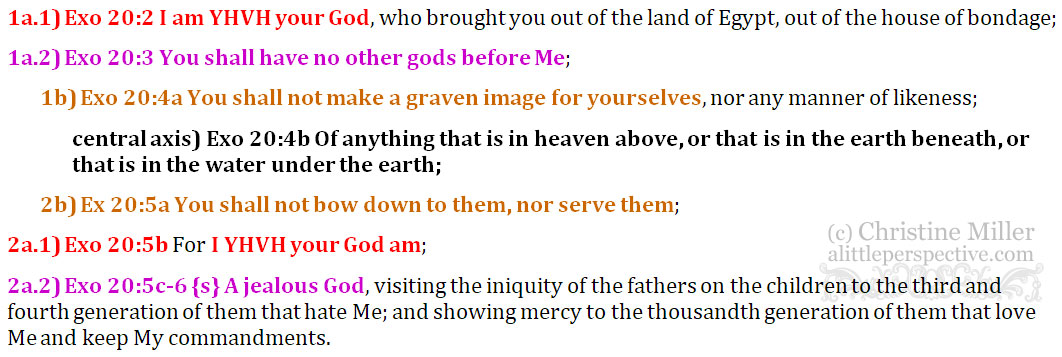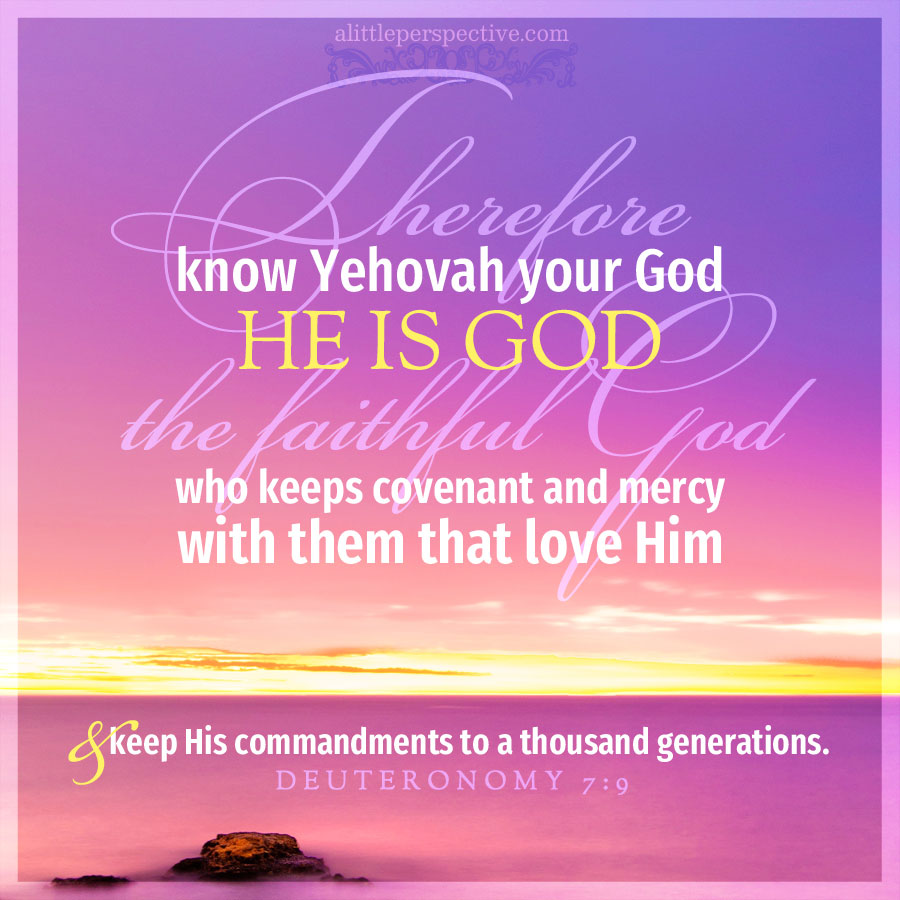Read Exodus 20:4-6 at Bible Gateway.
Hebrew paragraph division
Exo 20:2-6 {s} Israel shall have no gods before YHVH
The Hebrew paragraph divisions do not place the first and second commandments in separate paragraphs, as they do all the other commandments. This means that to God, the two, Have no gods before Me, and Do not make idols, are intrinsically connected. Obeying the one means obeying the other; conversely, violating one means violating the other.
Hebrew roots
Jealous is Strong’s H7067 qanna, an adjective meaning, “jealous as not bearing with any rival;” from Strong’s H7065 קנא qana, a primitive root meaning, “to envy, be jealous, be zealous for.” The ancient pictographs are quph + nun + aleph.
quph ק = sun on the horizon, thus condense, circle, time
nun נ, ן = the seed, thus continue, heir, son
aleph א = the ox head, thus strength, power, leader
The related words of nest, possessions, gather, in this root family sheds light on the story. Gathering (quph, as the light is gathered to the sun when it is on the horizon) materials for the next generation (nun, as the parent birds gather materials to make the nest for their eggs):
The parent bird will guard over and protect the nest and eggs from predators. Man can guard over the family, wife, [and] possessions in a positive way (protect, from an enemy) or in a negative way (by not trusting or a desire to have another’s possessions).
Dr. Jeff Benner, The Ancient Hebrew Lexicon
So then, the story being told is of gathering (quph) materials for the next generation (nun) from a strong motivation (aleph) that produces a corresponding protectiveness, zealousness, or jealousy.
Hate is Strong’s H8130 שנא sane, a primitive root meaning, “to hate.” We have seen this root before.
Love is Strong’s H157 אהב ahab, a primitive root meaning, “to desire, to breathe after.” We have seen this root before.
Mercy is Strong’s H2617, chesed, an abstract concept meaning, “lovingkindness, mercy;” from Strong’s H2616 חסד chacad, a primitive root meaning, “to be loving, kind.” We have seen this root before.
Keep is Strong’s H8104 שמר shamar, a primitive root meaning, “to keep, to guard, to preserve.” We have seen this root before.
Commandment is Strong’s H4687, mitsvah, a concrete noun meaning, “commandment;” from Strong’s H6680 צוה tsavah, a primitive root meaning, “to set up, to constitute, to appoint.” We have seen this root before.
Exo 20:2-6 chiastic structure

The structure brings out the point that the prohibition on graven images and likenesses is as objects of worship. Scripture confirms this later in Exodus when God explicitly gives instruction to make the cherubim over the mercy seat, which are three dimensional likenesses after all:
And you shall make two cherubim of gold; of hammered work you shall make them at the two ends of the mercy seat. Exo 25:18
God’s truth cannot contradict itself and remain truth; therefore we know that the truth being taught in the second commandment is not to make likenesses as objects of worship.
In our day it is not as common to venerate an object as it was in ancient days; yet in our day it is still very common to set up idols and venerate them. In our day it is common to venerate concepts such as money, fear of man, power, influence, fame, or even children, career, hobbies, and other things as idols. The commandment, Do not make idols, holds.

















I really enjoy your posts and you are the first to teach me about chiastic structures and also the Hebrew paragraph divisions which are both very insightful.
Is there more than one way to see a chiastic structure? Are there any hard and fast rules or is it sort of a structured art?
When I looked at this one, I saw it slightly different. This is how I saw it:
A 20:2 I am YHWH your God (brought out of Egypt/bondage -past action)
B 20:3 You shall have no other gods before me.
Central axis (all of this verse) 20:4 You shall not make a graven image for yourselves, nor any manner of likeness of any thing in heaven above, or in the earth beneath, or in water under the earth.
B 20:5a You shall not bow down to them, nor serve them.
A 20:5b for I YHWH your God a jealous God …(will visit iniquity or show mercy- future action)
Does this chiastic structure work?
Also I have wondered much on this commandment in light of Exodus 25:18, the cherubim and also the brazen serpent in Numbers 21:9 and 2 Kings 19:4.
I wonder if we had the ark of the covenant today if people would not be tempted to worship it? And do some people in a way still worship the brazen serpent through the medical establishments that adopted it as its symbol? Just typing my thoughts out loud…
Appreciate your knowledge and insights. Blessings:)
Yes there can be more than one way to see a structure, especially since there can be overlapping structures that share elements. Thank you for posting your structure, I really like it, it is a very valid structure.
I recently taught a webinar on the Teaching Tools of Scripture including chiastic structures which might be helpful: https://www.youtube.com/watch?v=7-VcLiHNbHg
I don’t know if people would worship the ark if it was extant today. However many cultures today still have idols which are worshiped, so the command to not make idols to worship applies across all cultures and across all ages as do the rest of the Ten Commandments.
Interesting thought about the brazen serpent and its connection to the medical establishment. Every good thing which God has given can be turned into an evil if we venerate it before God.